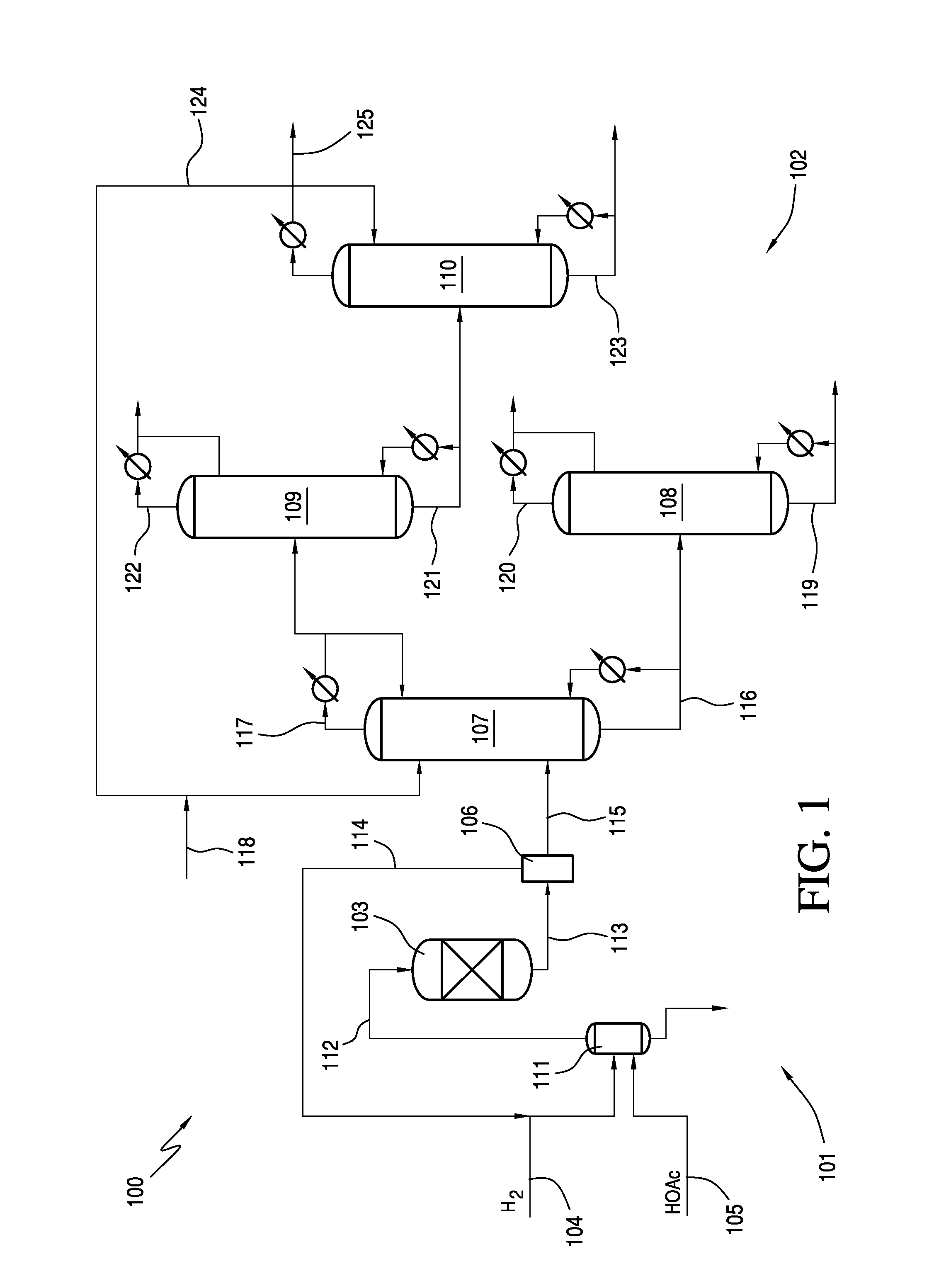Distillation of Crude Alcohol Product Using Entrainer
a crude alcohol product and distillation technology, applied in the field of low-energy process for recovering ethanol using an entrainer, can solve the problems of difficult separation, limited production and recovery of ethanol from such reaction mixtures, and unreacted acid remains in the crude ethanol produ
- Summary
- Abstract
- Description
- Claims
- Application Information
AI Technical Summary
Benefits of technology
Problems solved by technology
Method used
Image
Examples
examples
[0093]The following examples were prepared with ASPEN Plus 7.1 simulation software to test various feed composition and separation systems.
example a
[0094]A crude ethanol product comprising 56 wt. % ethanol, 38 wt. % water, 2% acetaldehyde, 2% ethyl acetate, 1 wt. % acetic acid, and 1 wt. % other organics is fed at about 343502 lb / hr into an distillation column. Diethyl ether was also fed at 2000 lb / hr above the feed point of the crude ethanol product. This first column contains 75 trays with the entrainer feed location at the 29th tray from the bottom and crude ethanol product feed location at the 15th tray from the bottom. The reflux rate is 24 times the distillate rate. The distillate temperature was 74.8° C. and the residue temperature was 103.8° C. The pressure of the column was 170.3 kPa. The distillate and residue compositions are shown in Table 7.
TABLE 7Component (wt. %)DistillateResidueEthanol37.6 57.6Water6.041.3Ethyl Acetate20.6 Acetic Acid1.1Acetaldehyde15 Other organics15 Entrainer5.8(diethyl ether)
[0095]The amount of ethyl acetate leakage in the residue was 12 ppm. The amount of diethyl ether leakage in the resid...
example b
[0096]Operating under similar conditions as Example A except the feed rates of the entrainer was increased to 10,000 lb / hr. The distillate and residue compositions are shown in Table 8.
TABLE 8Component (wt. %)DistillateResidueEthanol22.857.8 Water 5.940.3 Ethyl Acetate20.4Acetic Acid 1 Acetaldehyde15 Other organics14.8Entrainer21 0.88(diethyl ether)
[0097]The amount of ethyl acetate leakage in the residue was 15 ppm. The amount of ethyl acetate recovered from the crude ethanol product was 99.93%. The energy (per MMBtu / ton of EtOH refined) was 2.68 for Example B, which is lower than the energy for Example A of 3.11.
PUM
| Property | Measurement | Unit |
|---|---|---|
| wt. % | aaaaa | aaaaa |
| wt. % | aaaaa | aaaaa |
| wt. % | aaaaa | aaaaa |
Abstract
Description
Claims
Application Information
 Login to View More
Login to View More - R&D
- Intellectual Property
- Life Sciences
- Materials
- Tech Scout
- Unparalleled Data Quality
- Higher Quality Content
- 60% Fewer Hallucinations
Browse by: Latest US Patents, China's latest patents, Technical Efficacy Thesaurus, Application Domain, Technology Topic, Popular Technical Reports.
© 2025 PatSnap. All rights reserved.Legal|Privacy policy|Modern Slavery Act Transparency Statement|Sitemap|About US| Contact US: help@patsnap.com


